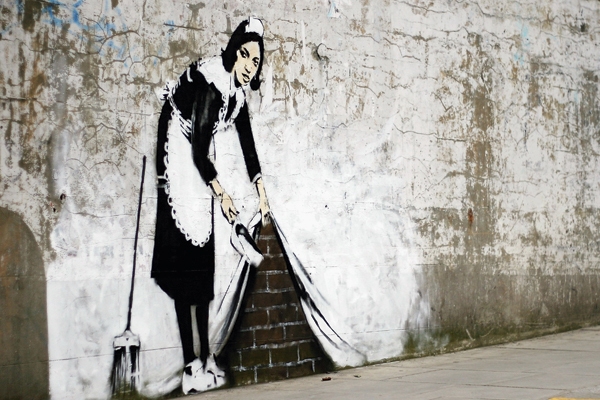What to make of Banksy? Artist or vandal? Tate Modern holds no Banksys and, other than a redundant phone box that he folded in half and pretended to have reconfigured with a pickaxe, Banksy has never destroyed anything. So I ask my 15-year-old son what he knows of him: ‘He’s the guy who did the policeman with the Tesco bag, who does really cool graffiti, not lame stuff, and no one knows who he is.’
Actually, we do know who he is. His identity was discovered some years ago by the Daily Mail, an organ neither beloved nor believed by those who follow Banksy. But because the public loves a mystery I shall follow Will Ellsworth-Jones in his coy refusal to give the name away in this competent, broadly sympathetic and enjoyable book.
Banksy was born in Bristol in 1973 and educated at the Bristol Cathedral Choir School. His wit, apostrophe-placement and spelling (apart, that is, from the word ‘graffiti’, which he misspelled on a wall in the Portobello Road) suggest that he was an interested student.
He began drawing pictures on walls in his late teens, using stencils. A number of his images are now familiar: the rat, the rioter hurling a bunch of flowers, the kissing policemen. Another, a girl losing a red balloon, turned up a few weeks ago on a wastewater drum in Thurso, causing great excitement at the John O’Groats Journal. Banksy, through his company Pest Control, does not ‘authenticate’ graffiti, so whether it is a ‘real’ Banksy or merely a copy we may never know.
His politics are standard yes-we-know agit-prop — war is horrid, uniforms are scary, poverty is bad — but Banksy’s graffiti, on the whole, is the kind of graffiti people like. It is graphically clean and invariably draws a smile by way of visual pun, trompe l’oeil or oxymoron. His pranks are chucklesome (wheel-clamping Boadicea’s chariot in Parliament Square).
He also has an almost Chestertonian love of mildly paradoxical aphorism: ‘Become good at cheating and you never need to become good at anything else’, ‘People say graffiti is ugly, irresponsible and childish, but that’s only if it’s done properly’, ‘We can’t do anything to change the world until capitalism crumbles. In the meantime we should all go shopping to console ourselves.’ Not perhaps up to ‘If a thing is worth doing, it is worth doing badly’, but nonetheless more refreshing than the usual artspeak.
The people who don’t smile are local council officers, who reckon Banksy is a vandal, hoodies with spray cans, who reckon Banksy has sold out and is no longer a vandal, and Guardian columnists, who can’t quite decide what to think.
Despite the general public’s idea of him as a sort of Macavity of graffiti, Banksy does do works on canvas and paper, and these sell for lots of money (‘Bombing Middle England’ went for over £100,000 at auction). This makes him uncomfortable, so he gives lots of it away, and his exhibitions are always free.
These exhibitions are ‘events’, usually involving live animals: for Turf War, held in a warehouse in Hackney in 2003, Banksy painted on sheep and cows. For Crude Oils in Notting Hill in 2005 he filled the gallery with live rats. Barely Legal, in Los Angeles, introduced an elephant (pictured above) entirely painted in the pattern of the wallpaper of its enclosure.
Banksy finds it hard to go wrong: even his first film was nominated for an Oscar. Like most of the best satire, Exit Through the Gift Shop, is of a conservative bent. The first half is concerned with the daring and expertise of what have come to be known as ‘street artists’. The second is a demonstration of how easy it is to ride the wave of a trend — ‘street art’ — and how gullible the arty public can be. In this sense the film perfectly renders the difficulty in which Banksy finds himself. Celebrated as an artist, his work fetching huge prices, he wants to retain the freedom and anonymity of the ‘graffiti vandal’. He can take solace in the fact that wherever in the world measures are announced to deal with graffiti (usually the ‘lame’ tags and squiggles my son despises) his name is evoked.
Will Ellsworth-Jones’s book hardly reveals ‘the man behind the wall’, but it does make clear how voracious a beast the art market is, and charts lucidly the way in which Banksy, a brilliant organiser, has tried to manipulate it to his own ends. Ellsworth-Jones is also good on ‘Team Banksy’, and the way in which it protects his anonymity and his interests. It speaks well for Banksy that so few people can be persuaded to talk openly about him.
I’d rather have a Banksy on my gatepost than a Hirst above my sofa, if only for the smiles of passers-by. What either of them have to do with art is for the ages to decide.






Comments